

Nineteenth Century Inventions 1800. 5 19th-Century Utopian Communities in the United States — HISTORY Lists. The philosophical movement known as Transcendentalist was in full swing when Unitarian minister George Ripley founded Brook Farm in the rural Boston suburb of West Roxbury in 1841.

The community wasn’t particularly unique for its time—after all, more than 80 utopian communities were launched in the 1840s alone—but it was notable as the first purely secular one. Members farmed the land together and held the fruits of their labor in common. The idea was that this would give settlers more time to pursue their own literary and scientific interests, which would then benefit the rest of humankind.
Money troubles and internal squabbling eventually eroded the community, which disbanded after only a few years in existence. Founding member Nathaniel Hawthorne ended up having a pretty miserable time there, which he would later document in his fictionalized account of Brook Farm, “Blithedale Romance.” Chris Light/Wikimedia Commons. Religious Transformation and the Second Great Awakening. Both blacks and women began to participate in evangelical revivals associated with the Second Great Awakening at the end of the 18th century.
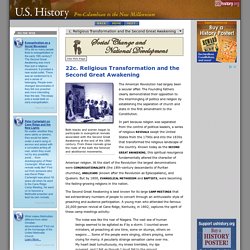
From these revivals grew the roots of the both the feminist and abolitionist movements. The American Revolution had largely been a secular affair. Women's Rights. Amelia Bloomer's magazine, The Lily advocated a new outfit for women, consisting of a loose top, long pantaloons, and a knee-length dress.
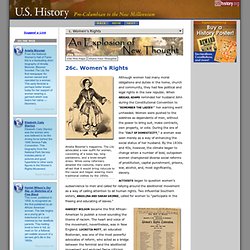
While some reformers adopted the costume, many were afraid that it would bring riducule to the cause and began wearing more traditional clothes by the 1850s. Although women had many moral obligations and duties in the home, church and community, they had few political and legal rights in the new republic. When Abigail Adams reminded her husband John during the Constitutional Convention to "Remember the Ladies! " her warning went unheeded. Background of the Mill Girls. The Lowell Mill Girls Go on Strike, 1836. By Harriet Hanson Robinson A group of Boston capitalists built a major textile manufacturing center in Lowell, Massachusetts, in the second quarter of the 19th century.
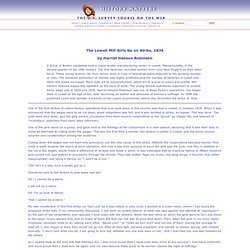
The first factories recruited women from rural New England as their labor force. African American Odyssey. During the course of the slave trade, millions of Africans became involuntary immigrants to the New World.
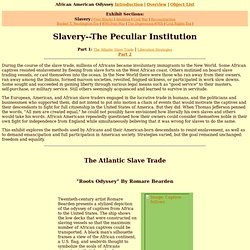
Some African captives resisted enslavement by fleeing from slave forts on the West African coast. Others mutinied on board slave trading vessels, or cast themselves into the ocean. In the New World there were those who ran away from their owners, ran away among the Indians, formed maroon societies, revolted, feigned sickness, or participated in work slow downs. Some sought and succeeded in gaining liberty through various legal means such as "good service" to their masters, self-purchase, or military service.
Still others seemingly acquiesced and learned to survive in servitude. This exhibit explores the methods used by Africans and their American-born descendants to resist enslavement, as well as to demand emancipation and full participation in American society. Slavery--The Peculiar Institution: Part 1 | Part 2 African American Odyssey Introduction | Overview | Object List. The Underground Railroad. The Underground Railroad, a vast network of people who helped fugitive slaves escape to the North and to Canada, was not run by any single organization or person.

Rather, it consisted of many individuals -- many whites but predominently black -- who knew only of the local efforts to aid fugitives and not of the overall operation. Still, it effectively moved hundreds of slaves northward each year -- according to one estimate, the South lost 100,000 slaves between 1810 and 1850. An organized system to assist runaway slaves seems to have begun towards the end of the 18th century. In 1786 George Washington complained about how one of his runaway slaves was helped by a "society of Quakers, formed for such purposes. " Harriet Tubman — History.com Articles, Video, Pictures and Facts.
In 1849 Tubman fled Maryland, leaving behind her free husband of five years, John Tubman, and her parents, sisters, and brothers.

“Mah people mus’ go free,” her constant refrain, suggests a determination uncommon among even the most militant slaves. She returned to the South at least nineteen times to lead her family and hundreds of other slaves to freedom via the Underground Railroad. Utilizing her native intelligence and drawing on her boundless courage, she eluded bounty hunters seeking a reward for her capture, which eventually went as high as forty thousand dollars. She never lost a fugitive or allowed one to turn back. Two things sustained her: the pistol at her side and her faith in God. Tubman collaborated with John Brown in 1858 in planning his raid on Harpers Ferry. Abolitionist Movement — History.com Articles, Video, Pictures and Facts. From the 1830s until 1870, the abolitionist movement attempted to achieve immediate emancipation of all slaves and the ending of racial segregation and discrimination.
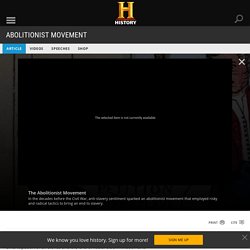
Their propounding of these goals distinguished abolitionists from the broad-based political opposition to slavery’s westward expansion that took form in the North after 1840 and raised issues leading to the Civil War. Yet these two expressions of hostility to slavery–abolitionism and Free-Soilism–were often closely related not only in their beliefs and their interaction but also in the minds of southern slaveholders who finally came to regard the North as united against them in favor of black emancipation. Although abolitionist feelings had been strong during the American Revolution and in the Upper South during the 1820s, the abolitionist movement did not coalesce into a militant crusade until the 1830s.
But as antislavery sentiment began to appear in politics, abolitionists also began disagreeing among themselves. The Gold Rush of 1849 — History.com Articles, Video, Pictures and Facts. Throughout 1849, people around the United States (mostly men) borrowed money, mortgaged their property or spent their life savings to make the arduous journey to California.

In pursuit of the kind of wealth they had never dreamed of, they left their families and hometowns; in turn, women left behind took on new responsibilities such as running farms or businesses and caring for their children alone. The Transportation Revolution: Turnpikes to Steamboats to Railroads. Last revised: March, 2014 Acceptance of Terms Please read this Terms of Service Agreement ("Terms of Service", "Terms of Use") carefully.

These terms apply to Education Portal and its related websites owned and operated by Remilon, LLC ("Education Portal,", "Site", "Sites", "our", "us"). Manifest Destiny. Library of Congress In the 1850s trains were leaving Washington for the West twice daily. Expansion westward seemed perfectly natural to many Americans in the mid-nineteenth century. Like the Massachusetts Puritans who hoped to build a "city upon a hill, "courageous pioneers believed that America had a divine obligation to stretch the boundaries of their noble republic to the Pacific Ocean.
The U.S.-Mexican War. War of 1812 — History.com Articles, Video, Pictures and Facts. Native American Resistance in the Trans-Appalachian West. Tenskwatawa, also known as Prophet (pictured here), worked with his brother Tecumseh to create a broad-based tribal coalition which would resist American encroachment from the east. In the 16th, 17th, and 18th centuries, the first white settlers in America inhabited the eastern seaboard. There the whites either made treaties with the Native American groups to buy land or they forcibly took Indian land. Indian removal. Early in the 19th century, while the rapidly-growing United States expanded into the lower South, white settlers faced what they considered an obstacle.
This area was home to the Cherokee, Creek, Choctaw, Chicasaw and Seminole nations. These Indian nations, in the view of the settlers and many other white Americans, were standing in the way of progress. Eager for land to raise cotton, the settlers pressured the federal government to acquire Indian territory. Andrew Jackson, from Tennessee, was a forceful proponent of Indian removal. In 1814 he commanded the U.S. military forces that defeated a faction of the Creek nation. Andrew Jackson Biography. Andrew Jackson was the seventh president of the United States. He is known for founding the Democratic Party and for his support of individual liberty. Synopsis. Thomas Jefferson Biography. Thomas Jefferson was a draftsman of the Declaration of Independence and the third U.S. president (1801-09). He was also responsible for the Louisiana Purchase. Synopsis Thomas Jefferson was born on April 13, 1743, in Shadwell, Virginia.
He was a draftsman of the U.S. Lewis and Clark. Louisiana Purchase — History.com Articles, Video, Pictures and Facts.